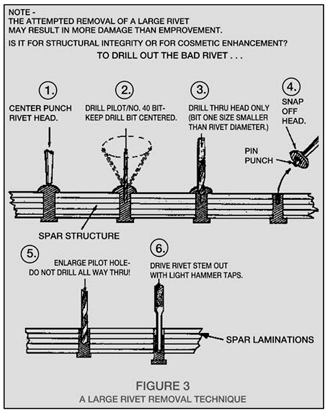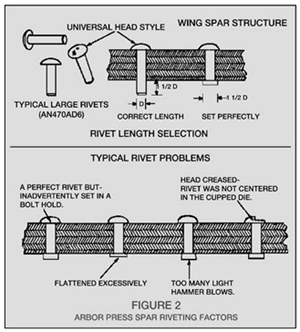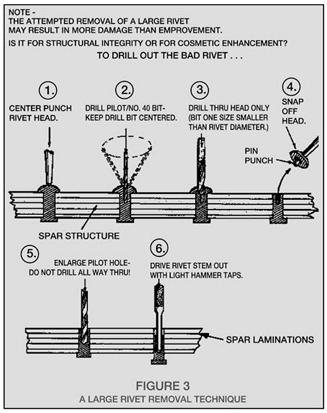Rivets: Keeping it all together
By Tony Bingelis (originally published in Sportplane Builder, May 1993)
Anyone building one of the Van’s Aircraft all-metal RV series kits has a number of options to choose from. One such option is to have the wing spars factory assembled . . . for a price, of course (approximately $700).
For that amount you receive prefabricated spars that are beautifully anodized, and really are quite impressive. Furthermore, you can tell yourself that the factory completed spars actually represent but a small portion of the overall project cost.
However, $700 is a lot of money and more and more builders are "biting the bullet." That is, they are undertaking the spar assembly work themselves.
Much to their surprise, they learn that the dreaded spar assembly is simpler than expected. But best of all, by doing their own spar work those extra hundreds of dollars saved are better used for the purchase of instruments or other essential goodies.
Here is why the RV-4 and RV-6 spar assembly is no longer as difficult for the builder as it used to be. Now all of the wing spar webs and spar flanges are pre-drilled at the factory for accuracy . . . and in the interest of safety.
The one exception I found is the comparatively neglected RV-3 kit. You still have to do all the precise spar assembly drilling yourself, and even make do with some hand-me-down RV-4 substitute parts that have to be modified to fit.
What The Spar Assembly Entails
1. Restudy the spar instructions and drawings carefully before you do anything else.
2. The optional, but worthwhile, tapering of each spar reinforcement strip to reduce weight. A band saw is used to simplify and speed up this work.
3. Cutting out the spar web lightening holes to save weight and to permit easier access during assembly.
4. Deburring and smoothing the edges of the individual spar component parts.
5. Priming each part with a good zinc chromate primer . . . like DuPont’s Variprime, for example.
6. Assembling the various spar components and clamping the spar web strips in place with temporary 3/16" diameter commercial bolts and plain nuts.
Note: Insert a bolt in every hole that does not need a rivet. This is very important because nobody deserves having to drill out a perfectly good rivet just because it doesn’t belong there. Besides, drilling out a long 3/16" rivet through multiple layers of solid aluminum is a risky job. It will be difficult to drive out the old rivet, and in trying to do so, you may, unfortunately, enlarge the hole by misdrilling it. Figure 3 shows one way to handle that delicate task.
7. Inserting each rivet and setting it using one of the following methods:
a. A slow hitting heavy duty 3X, or larger capacity, rivet gun that has good finger control, or
b. A pneumatic rivet squeezer of adequate capacity, or
c. The Avery Hand Riveting and Dimpling Tool and a heavy hammer.
d. The short handle sledge/arbor press technique.....is the least expensive heavy rivet setting method of all.
Tips For Using A Heavy Duty Rivet Gun
Some builders find that a 3X gun is a bit weak and requires an excessive number of blows to set a 3/16" rivet. This is undesirable as numerous light blows tend to flair the end of the rivet and work-harden it. This usually results in poor workmanship.
The heavy duty rivet gun method works best with the spar assembly clamped or otherwise immobilized in a vertical position.
I recommend that you have somebody handle the heavy bucking bar. By heavy I mean a bucking bar that weighs at least 5 pounds. None of the typical 2-3 pound bucking bars you may already have purchased will be heavy enough for bucking the large 3/16" diameter rivets.
Having somebody handle the bucking bar will allow you to use both hands on the rivet gun. Remember, the rivet gun must be pressed hard against the rivet to prevent the gun from bouncing and making a "smiley" (a crease in the rivet head).
It will take some practice to develop the skill necessary to flatten the shop heads to a uniform height and diameter. By the time you have finished setting all the rivets in the spars you will be pretty good with the rivet gun.
Of course, it will be too late to correct the rivets flattened excessively, but you can still correct the rivets that need to be hit a bit more.
In setting big rivets with a rivet gun, try to form the shop heads with as few blows as possible to avoid work-hardening and cracking the formed rivet heads.
Using A Pneumatic Squeeze Riveter
As for buying one of these jewels, the cost is upwards of $1,000 . . . it would be cheaper to order the ready-made spars.
However, if you are, indeed, buying one of the pneumatic rivet squeezers, assure yourself that it will be one that can reach all the rivet locations in your spar. Furthermore, the gap between the jaws of the squeezer must be large enough to straddle your built-up spar strap lamination.
Unfortunately, the longer the reach of these squeeze riveters, the smaller the rivet size they can handle.
Your rivet squeezer, in order to handle the 3/16" diameter rivets, should be capable of exerting about a 6,000 pound compression force.
Because these pneumatic rivet squeezers are heavy, they are quite tiring to handle. The exception is the bench mounted type - but the cost of one of these is almost twice that of the handheld versions.
Nevertheless, the advantages of using a pneumatic squeezer are obvious. You can, without help, set all the rivets perfectly and complete the job much sooner, too.
Using the Avery Hand Riveting Dimpling Tool
With the help of a heavy hammer or a short handled light sledge, this arbor can do a respectable job of setting your 3/16" spar rivets.
The tool is most effective when it is resting on a solid base like a concrete floor.
The rivet is inserted from the bottom up. That is, the rivet head will rest in the correct size cupped squeezer die normally used with AN-470AD Universal Head rivets. The tool’s steel driver is lowered onto the rivet’s shank and struck sharply with a heavy hammer. Several hammer blows will be necessary.
The tool may not hold up very well if many large rivets have to be upset.
Using the Sledge Hammer/Arbor Press Technique
The idea for this poor boy rivet squeezing technique simply evolved when a local RV-6A builder (Kent Williams of Round Rock, TX) balked at the idea of parting with all that money for a factory assembled spar. After a lot of thinking, he finally worked out the ultimate solution.
He made his own version of a heavy duty compression rivet squeezer (it sure doesn't look like one) by modifying an inexpensive one ton arbor press to accept a standard cupped squeezer die. He planned to increase the arbor’s compression force capacity, manually, with the aid of sledge hammer blows as a substitute for pneumatic pressure.
The price tag for this heavy duty riveting device cost much less than either a 3X rivet gun or a pneumatic rivet squeezer . . . and even less than that Avery Hand Riveting and Dimpling Tool which was designed, primarily, for skin dimpling chores.
Kent’s arbor press came from Harbor Freight Tools in California.
As for the short handle 3-1/2 pound sledge hammer, he already had one.
All he had to do to adapt the arbor press to set rivets was to drill a hole in the movable slotted table plate to accept a standard .187 shank Universal AN470 cupped rivet die.
To use the arbor press/sledge hammer squeeze riveter:
1. Insert a rivet in the spar with its head down and centered carefully in the cupped rivet set die.
2. Lower the arbor’s square ram onto the shank end of the rivet.
3. Apply pressure with the lever, and whack the top of the protruding ram with 4 or 5 sledge hammer blows.
That’s it. The rivet will be perfectly set.
Here are a couple of tips which can help improve your technique for using this rivet squeezer.
Sometimes, a rivet will be difficult to insert all the way into a tight rivet hole. To ensure that the rivet is fully seated, place a small block of wood, with a 1/4" hole in it, centered over the protruding rivet shank. Lower the arbor’s driver against the wood block using only light pressure on the lever. You will be able to feel that the rivet head is snugged solidly against the spar.
Before you set the rivet, be sure the spar is supported in a fairly level attitude.
You will find that it is not necessary to pull down very hard on the lever . . . it is the sledge hammer blows that do most of the work of flattening the rivet and forming the shop head.
Keep a cordless drill fitted with a reamer handy to clean up a hole that refuses to accept a rivet without resorting to force.
Never try to force a rivet into a tight hole with light hammer taps. That may cause the rivet to swell and jam hard inside the hole from the hammer blows.
Then you will have a real problem because the rivet won’t go in, and it won’t come out without some sort of drastic action on your part.
Always use the correct length rivet (see Figure 2). If necessary, use a rivet cutter to cut the rivet to the exact length you need for a particular location.
Remember, the rivet should protrude about 1-1/2 its diameter. If it is longer than that it will probably bend during the shop head forming.
If You Have To Remove A Large Rivet . . .
This is not easy to do when the set rivet is a large diameter one (3/16" or larger) and it goes through several layers of aluminum. That rivet will have expanded so much that it virtually appears to be fused in the hole.
If, due to carelessness, a rivet head has merely been creased somewhat creating a "smiley," swallow your pride and let that rivet stay. Same thing for a rivet that has had its shop head flattened excessively. These rivets are best left untouched as you may inflict greater damage by trying to drill them out.
If you have no choice but to remove a large rivet that shouldn't be there, for example, try the technique illustrated in Figure 3. The steps are as follows:
1. Punch mark the center of the rivet head.
2. Carefully drill a small #40 pilot hole part way into the rivet head. Keep the drill bit centered.
3. Next, using a drill bit that is one size smaller in diameter than the 3/16" rivet shank, drill through the rivet head only.
4. If the rivet head fails to come off, you have allowed the drill to get off center. In that case knock off the rivet head with a drift, nail set, or a small chisel. It shouldn't take much to pop it off.
5. Enlarge the pilot hole with the undersized drill bit keeping it centered the best you can. Do not drill all the way through the rivet.
6. Finally, use a 1/8" nail set or drift to drive the rivet shank out with a few light hammer taps.
It is amazing how stubborn a rivet can be when you want to remove it. Makes you wonder if there is really any need to remove a large long rivet simply for cosmetic reasons.
However, should you inadvertently install a rivet in a hole originally destined for a bolt . . . you have no choice but to remove it.



